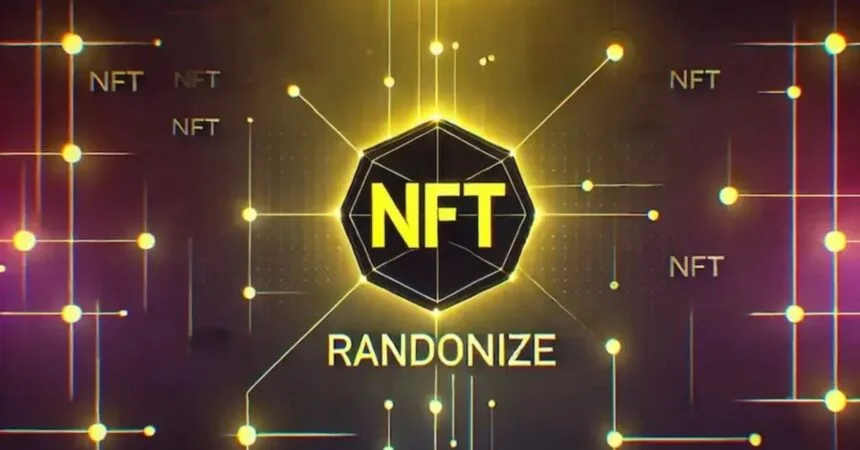The world of digital assets has evolved significantly with the rise of NFTs (Non-Fungible Tokens). NFTRandomize is the latest innovation, offering users a way to generate randomized NFTs, making each creation truly unique. As digital art, collectibles, and virtual goods gain momentum, understanding how NFTRandomize operates becomes essential for artists, collectors, and investors.
This article will explore the key concepts behind NFTRandomize, its importance in the NFT ecosystem, and its real-world applications. Additionally, we will address challenges users may encounter and offer solutions for overcoming them.

What is NFTRandomize?
NFTRandomize is a tool or platform that generates randomized NFTs from predefined sets of assets or parameters. These assets can include visual elements, metadata, or traits that are combined to create a unique digital token. Unlike traditional NFTs where the creator manually designs each token, NFTRandomize uses algorithms to produce distinct combinations.
This process ensures that no two NFTs are exactly the same, boosting their rarity and value. By offering users the chance to own a one-of-a-kind digital asset, NFTRandomize adds an exciting new dimension to the NFT marketplace.Click here to know about how technology used to achieve goals.Learn more here clubneet.
How Does NFTRandomize Work?
NFTRandomize platforms typically rely on algorithms and smart contracts to automate the creation of NFTs. Here’s a breakdown of the process:
- Predefined Assets: Artists or developers upload a collection of assets (e.g., images, traits, or metadata) to the platform.
- Randomization Algorithm: The platform uses an algorithm to randomly combine different assets, ensuring each NFT is unique.
- Smart Contracts: Once the NFT is generated, a smart contract is used to mint the token on a blockchain, confirming its authenticity and ownership.
- Ownership and Transfer: The NFT can then be transferred, sold, or traded on secondary marketplaces, with ownership securely recorded on the blockchain.
The Importance of NFTRandomize in the NFT Ecosystem
NFTRandomize has become a key player in the rapidly growing NFT space. Its ability to generate one-of-a-kind tokens offers several important benefits for creators, collectors, and investors.
Boosting Creativity and Innovation
NFTRandomize empowers creators to expand their horizons by offering an automated way to produce unique digital assets. This encourages experimentation with different combinations of traits, colors, and designs that would be time-consuming to create manually.
For example, digital artists can produce thousands of distinct works in a fraction of the time it would take to make each individually. This allows for larger projects and more dynamic collections that appeal to a broader audience.
Increased Value Through Rarity
Rarity plays a crucial role in determining the value of NFTs. By randomizing assets and traits, NFTRandomize ensures that some combinations will be rarer than others. Rare NFTs often sell for higher prices, making this an attractive feature for investors looking to capitalize on unique digital goods.
Scalability for NFT Collections
Creating large-scale NFT collections can be a labor-intensive process. NFTRandomize simplifies this by automating the creation of multiple NFTs from a single set of assets. This scalability is particularly useful for projects looking to launch thousands or even millions of tokens at once, as seen in popular NFT collections like CryptoPunks or Bored Ape Yacht Club.
Applications and Use Cases of NFTRandomize
NFTRandomize has broad applications across various industries, from art to gaming and beyond. Below are some of the most notable use cases.
Art and Digital Collectibles
NFTRandomize is frequently used in the digital art space to create randomized artworks with unique combinations of colors, styles, and features. These artworks can be sold individually or as part of a larger collection, allowing artists to reach a wider audience.
Gaming and Virtual Worlds
In gaming, NFTRandomize can be used to generate randomized in-game assets like weapons, skins, or characters. These assets can offer players a personalized experience while maintaining rarity and value, contributing to the game’s economy.
For example, in a virtual world, players might use NFTRandomize to acquire randomized avatars or digital real estate, each with distinct characteristics.
Fashion and Merchandise
The fashion industry has also started to explore NFTRandomize for producing limited-edition digital clothing and accessories. These virtual items can be worn in digital environments or even paired with physical counterparts, giving consumers an exclusive experience.
Metaverse Integration
As the metaverse expands, NFTRandomize will play a key role in creating virtual assets that populate these digital worlds. Whether it’s avatars, buildings, or entire environments, the ability to generate endless unique combinations ensures the metaverse remains dynamic and diverse.
Challenges of NFTRandomize
While NFTRandomize brings many benefits, there are also challenges that users should be aware of. These issues range from technical limitations to concerns about market saturation.
Over-saturation of the Market
One challenge with NFTRandomize is the potential for market saturation. As more randomized NFTs are created, there is a risk that the market may become flooded with similar-looking assets, reducing their overall value.
Quality Control
Although NFTRandomize generates unique tokens, not all combinations will result in aesthetically pleasing or valuable creations. Ensuring quality control over the assets and traits used in the randomization process is essential for maintaining the integrity of the collection.
Technical Complexity
The algorithms behind NFTRandomize require advanced technical expertise to implement effectively. Developers need to build robust randomization systems and smart contracts to avoid bugs or exploits that could compromise the NFTs.
Solutions to NFTRandomize Challenges
To address these challenges, several solutions can be implemented:
Selective Randomization
One way to avoid market saturation and ensure quality control is through selective randomization. This involves curating the pool of assets more carefully, ensuring that each potential combination meets a certain standard of creativity or aesthetic value.
Limited Releases
Another solution is limiting the number of NFTs generated using NFTRandomize. By capping the number of tokens in a collection, creators can maintain scarcity, which helps preserve the value of each individual asset.
Enhanced Algorithm Customization
Developers can implement more advanced randomization algorithms that take into account artistic value or market trends. This ensures that generated NFTs align with current consumer preferences and remain desirable in the marketplace.
The Future of NFTRandomize
As NFTs continue to grow in popularity, the future of NFTRandomize looks promising. Advancements in AI, blockchain technology, and smart contracts will enhance the capabilities of these platforms, making them more sophisticated and user-friendly.
AI-Powered Creativity
Artificial intelligence could play a significant role in the future of NFTRandomize. AI algorithms could be used to analyze trends, user preferences, and market data to create more valuable NFTs. This could lead to even more innovative and unique digital creations.
Cross-Platform Integration
In the future, NFTRandomize may become more integrated with other digital platforms, such as social media, gaming, and virtual reality. This will allow users to seamlessly create and trade NFTs across multiple environments, making digital ownership more accessible and mainstream.
Sustainability Initiatives
With growing concerns about the environmental impact of blockchain technologies, NFTRandomize platforms may also adopt more eco-friendly solutions. This could include using energy-efficient blockchains or carbon offset programs to reduce the environmental footprint of minting NFTs.
Conclusion
NFTRandomize is revolutionizing the way digital assets are created, traded, and valued. By allowing for the randomization of assets, it offers creators a powerful tool to produce unique, scalable collections that appeal to a broad range of buyers. While challenges such as market saturation and technical complexity exist, solutions like selective randomization and limited releases can help maintain the quality and value of NFTs.
As technology continues to evolve, NFTRandomize will likely play an even more significant role in the NFT landscape, offering exciting possibilities for creators and collectors alike. With its potential to integrate into various industries, NFTRandomize is set to shape the future of digital ownership.
FAQs
1. What is NFTRandomize, and how does it work?
NFTRandomize is a tool that generates randomized NFTs from a set of predefined assets or traits. It uses algorithms to combine different elements, ensuring each NFT is unique. The process involves uploading assets, running the randomization algorithm, and minting the NFT on a blockchain using a smart contract.
2. How does NFTRandomize benefit artists and creators?
NFTRandomize helps artists create large collections of unique digital assets quickly and efficiently. It automates the process of combining various artistic elements, allowing for experimentation and creativity on a scale that would be impossible to achieve manually.
3. Are randomized NFTs valuable?
Yes, randomized NFTs can be valuable, especially when certain combinations of traits or assets are rarer than others. Rarity is a key factor in determining the value of NFTs, and randomization ensures that no two tokens are exactly the same.
4. What industries can benefit from NFTRandomize?
NFTRandomize has applications in various industries, including digital art, gaming, fashion, and virtual worlds. It allows for the creation of unique assets, characters, and merchandise that can be sold or traded on NFT marketplaces.
5. What challenges are associated with NFTRandomize?
Challenges include potential market saturation, quality control, and technical complexity. To address these issues, creators can use selective randomization, limit the number of NFTs produced, and implement more advanced algorithms to maintain the value and appeal of their collections.


